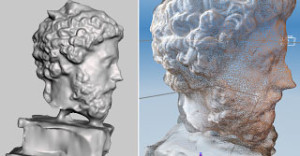Empires, it could be argued, are built upon successfully incorporating a vision as figurehead. Anyone can become as the figurehead, and one with the figurehead, by assimilating that vision. Be it Roman civility, Han unity, British industry or American liberty, nothing brings the conquered on board better than instilling in them the belief that they have been conquered for their own good, for the good of all… for the vision.
Today’s empires, arguably, tend to be of the mind, and of the market, more than of territory or military. Google has established one of the most powerful ’empires’ that the world has ever known in little over a decade. With a mission to collect and collate the world’s information (something even Hellenic Superman Alexander the Great would not have dared to suggest) and now with a new generation of input tools being deployed to enable it, the realm of the third dimension is an inevitable part of that vision. This article is about that vision being put to a good, educational use, made by Todd Blatt, who has blogged his recent 3D scan of Marcus Aurelius. He, casually, used Google Glass to capture hands-free photograph’s at the Walters Art Museum in Baltimore, US. Then the photos were sent to Autodesk’s 123D Catch, and assembled into a mesh, and cleaned up in Meshmixer.

He insists it really was that easy, indeed, invites you to download yourself a copy of the model online at Thingiverse.
What does a portable input device that is this quick and simple to use mean for 3D printing?
The short answer: Not much.
At least, probably not as much as it does for many other 3D rendering applications. The image cleanup is still going to put the majority of possible users off the 3D-photo-to-3D-print process.
But the possible users are not the concern, nor even the potential users, for the observant.

Consumer technology today, is, I would suggest, as driven by mysticism as the religions of yesterday: it is as much the promise of the magic of the experience, as the tangible personable benefit.
It is magic and awe that will spread Glass, and the possibility of capturing an image to be replicated at home. Not functionality. That will arrive after the shock of the new has subsided.
More shock and awe, not necessarily more ’empire’ for Google here, at least in the 3D printing sector?
Source: Todd Blatt Blog
Image Credit: Todd Blatt


